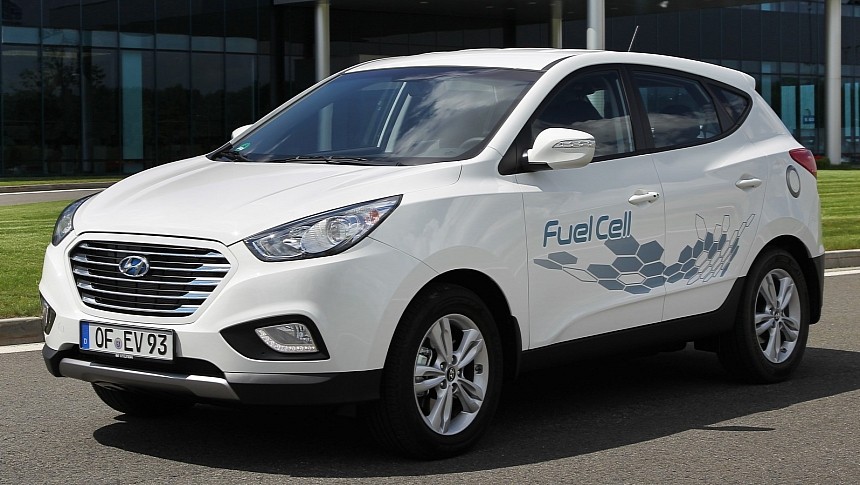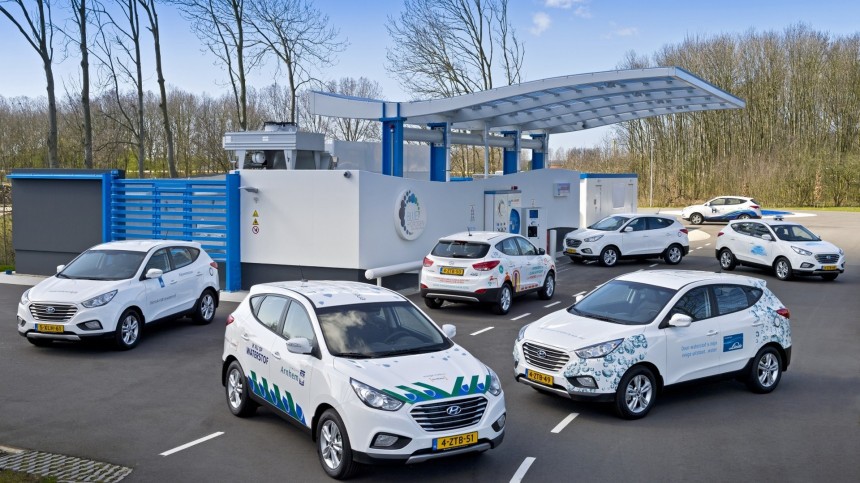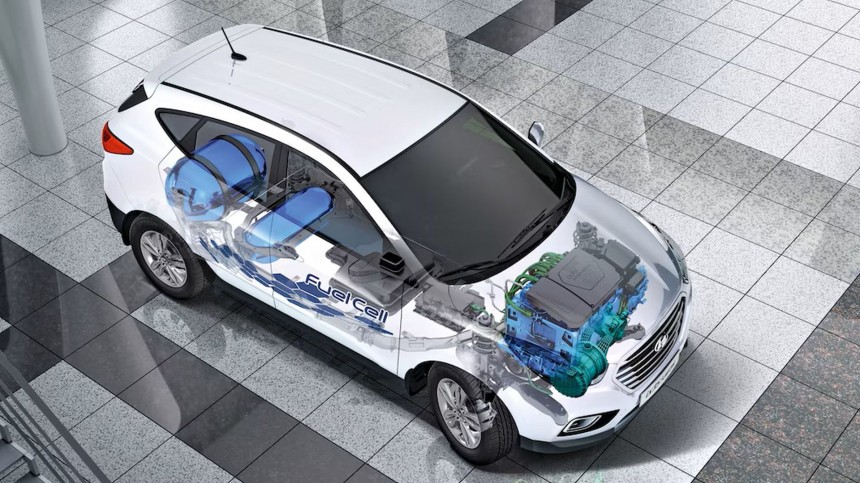Early adopters are necessary to test new technology and eventually see it go mainstream. At the same time, these guys sacrifice themselves for the privilege of being the first ones to try that tech. Till Westberg's story is a cautionary tale about the pleasures and pains of fitting that bill. After driving his 2016 Hyundai ix35 FCEV for 84,000 kilometers (52,195 miles) and seven years, he received a €103,764.17 ($113,139 at the current exchange rate) invoice.
That happened when the fuel cells in his Hyundai decided to stop working. The component alone costs €84,875 ($92,543), but you have to include service and taxes. That makes the $15,000 to $20,000 Tesla charges for its battery packs look like a bargain, but there are major differences that must be highlighted for anyone to have a fair assessment.
When people think that Toyota was the first company to sell a fuel cell electric vehicle (FCEV) in 2014 with the Mirai, that is not exactly true. The first company to do that was Hyundai in 2013, precisely with the ix35 FCEV. In some markets, it was called Tucson ix35 FCEV. Westberg bought his unit in 2016. According to Autobild, Hyundai made around 1,000 of these FCEVs.
The low production scale and the fact that the vehicle was a pioneer made things pretty tricky for the ix35 FCEV. Its fuel cells are now outdated compared to those used by the NEXO, and they are not interchangeable. Even if they were, the fuel cells for the NEXO cost €41,650 ($45,413), which is almost what Westberg paid for his car back in 2016: €50,200 ($54,736). Either way, the 2016 ix35 FCEV is a total loss.
If the vehicle had the same warranty as battery electric vehicles (BEVs), the Hyundai would still be covered. The bad news is that Hyundai only offered the fuel cells five years of legal protection. It would be interesting to ask Westberg if he had any idea of the cost to replace the component or that it was out of warranty for almost two years. Do NEXO owners know how much the fuel cells in their cars cost? They should.
According to Birgit Scheppat, car companies selling these vehicles should take really good care of these early adopters. The Rhein-Main University of Applied Sciences professor said Toyota protects Mirai owners as much as possible, but she did not tell Autobild how it does that. Our guess is that it buys these cars back should anything go wrong or just repairs them as if they were still under warranty. Hyundai is not that willing.
The Korean carmaker told Autobild that the repair is really very expensive and makes no financial sense. Used ix35 FCEVs are sold in Germany for around €20,000 ($21,807), so the new fuel cells cost four times what the car is worth. If Hyundai had them from a crashed vehicle, it could eventually replace them for Westberg, but it apparently did not offer to do so. In other words, the German customer is on his own.
As someone who traveled 114 km from Bad Homburg (where he lives) to Würzburg to fill up the hydrogen tanks in his FCEV, Westberg probably expected more. Autobild did not mention how much it cost to get the 5.64 kilograms (12.43 pounds) of this gas, but FCEV owners often complain about how expensive it is. Autobild did not comment if Bad Homburg already has a hydrogen station or if Westberg just had to travel a bit closer than in his first days with the Hyundai. According to the German driver, his car could travel 450 km (280 mi) to 500 km (311 mi) with a full tank. The Korean carmaker claimed a range of 594 km (369 mi). The NEXO presents better numbers: 666 km (414 mi) under the WLTP cycle.
As much as the ix35 FCEV depreciated over those years, it must be pretty hard for anyone to see a €50,200 investment vanish in a matter of seven years. Those who still believe they can protect the environment with their cars will either buy a BEV or just give up on vehicles, as several activists want people to do. The main benefit FCEVs and BEVs offer is to people's health.
Electric propulsion cuts the emission of dangerous pollutants like nitrogen oxides, hydrocarbons, ozone, and several others. Too bad that protecting your fellow human beings while driving often means a personal sacrifice when it comes to your budget. BEVs made on a large scale are yet to solve that. The few FCEVs for sale have just demonstrated they either can't address the problem or are just not interested in making things easier for early adopters. These customers are the ones who should weigh in if the compliments and the taps on their backs are enough for the predictable and severe financial hurdles their choices involve.
When people think that Toyota was the first company to sell a fuel cell electric vehicle (FCEV) in 2014 with the Mirai, that is not exactly true. The first company to do that was Hyundai in 2013, precisely with the ix35 FCEV. In some markets, it was called Tucson ix35 FCEV. Westberg bought his unit in 2016. According to Autobild, Hyundai made around 1,000 of these FCEVs.
The low production scale and the fact that the vehicle was a pioneer made things pretty tricky for the ix35 FCEV. Its fuel cells are now outdated compared to those used by the NEXO, and they are not interchangeable. Even if they were, the fuel cells for the NEXO cost €41,650 ($45,413), which is almost what Westberg paid for his car back in 2016: €50,200 ($54,736). Either way, the 2016 ix35 FCEV is a total loss.
According to Birgit Scheppat, car companies selling these vehicles should take really good care of these early adopters. The Rhein-Main University of Applied Sciences professor said Toyota protects Mirai owners as much as possible, but she did not tell Autobild how it does that. Our guess is that it buys these cars back should anything go wrong or just repairs them as if they were still under warranty. Hyundai is not that willing.
The Korean carmaker told Autobild that the repair is really very expensive and makes no financial sense. Used ix35 FCEVs are sold in Germany for around €20,000 ($21,807), so the new fuel cells cost four times what the car is worth. If Hyundai had them from a crashed vehicle, it could eventually replace them for Westberg, but it apparently did not offer to do so. In other words, the German customer is on his own.
As much as the ix35 FCEV depreciated over those years, it must be pretty hard for anyone to see a €50,200 investment vanish in a matter of seven years. Those who still believe they can protect the environment with their cars will either buy a BEV or just give up on vehicles, as several activists want people to do. The main benefit FCEVs and BEVs offer is to people's health.
Electric propulsion cuts the emission of dangerous pollutants like nitrogen oxides, hydrocarbons, ozone, and several others. Too bad that protecting your fellow human beings while driving often means a personal sacrifice when it comes to your budget. BEVs made on a large scale are yet to solve that. The few FCEVs for sale have just demonstrated they either can't address the problem or are just not interested in making things easier for early adopters. These customers are the ones who should weigh in if the compliments and the taps on their backs are enough for the predictable and severe financial hurdles their choices involve.












